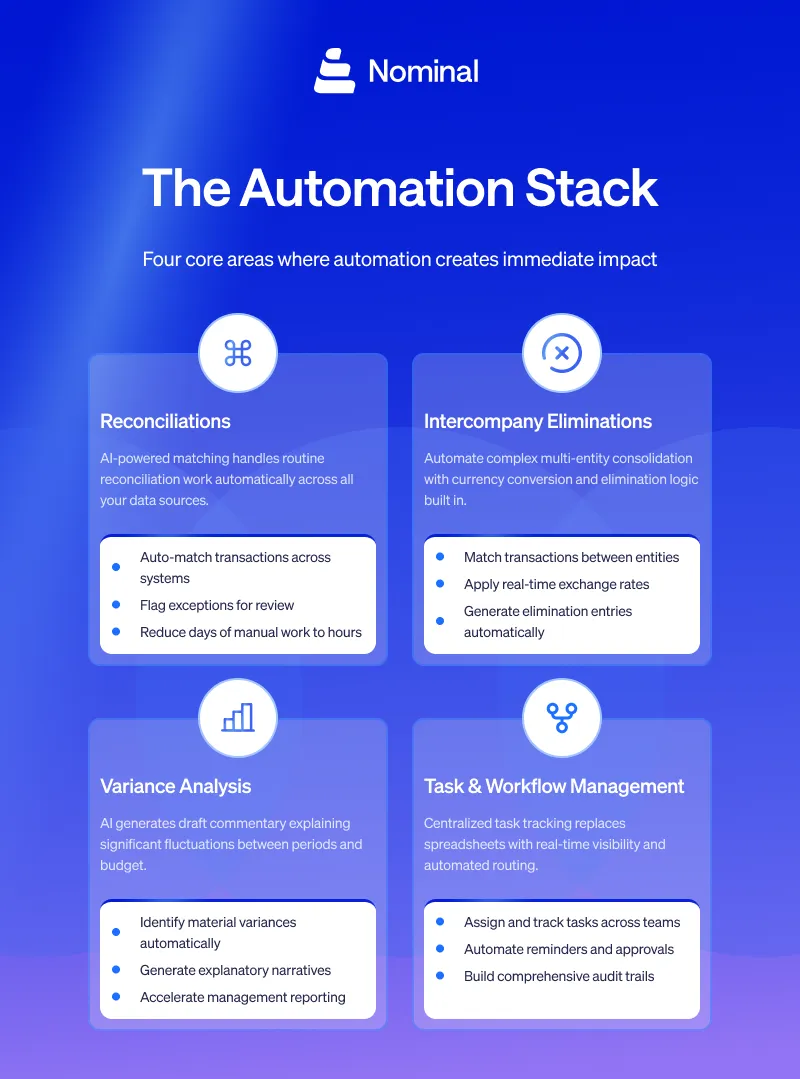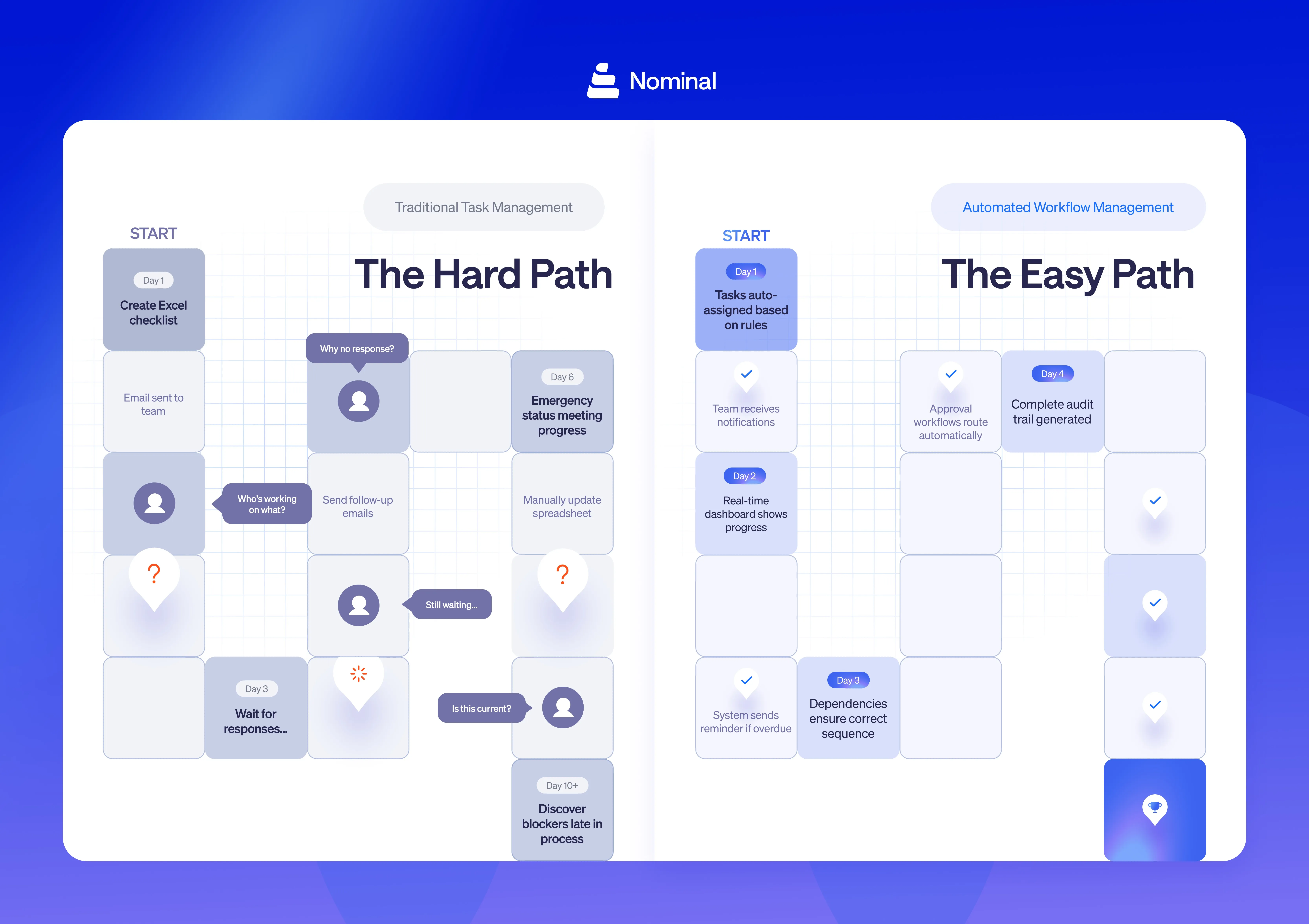Most finance teams spend the bulk of their close cycle on repetitive, predictable tasks. Matching transactions across systems. Converting currencies between entities. Tracking task completion through spreadsheets. Writing variance explanations from scratch. These activities consume days of effort each month while introducing errors and delaying strategic work.
The solution isn't replacing human judgment with technology. It's eliminating the manual work that prevents finance professionals from applying their expertise where it matters most. Automation handles the predictable matching, calculating, and tracking tasks that consume hours of time. Finance teams redirect that capacity toward analysis, insight generation, and strategic support that actually drives business decisions.
The Automation Stack: Core Areas of Opportunity
Modern close automation targets four critical areas where manual processes create bottlenecks, introduce errors, and consume disproportionate amounts of time.

Reconciliations
Account reconciliations traditionally require accountants to manually match transactions across subledgers, bank feeds, and intercompany accounts. The process involves comparing line items between different systems, identifying matches, and investigating discrepancies. For organizations with multiple entities and high transaction volumes, reconciliation can consume days of manual effort each month.
Automated reconciliation engines handle this matching work using AI-powered pattern recognition. The system learns from historical data to understand how transactions typically match across different sources. Bank statement entries automatically reconcile against general ledger records. Intercompany transactions identify their counterparts across entities. System-generated entries match between platforms without manual intervention.
The technology flags exceptions for human review rather than processing every transaction manually. Finance teams focus their expertise on genuine discrepancies that require investigation and judgment. A reconciliation process that previously took three days now completes in hours, with higher accuracy than manual methods ever achieved.
Intercompany Eliminations
Multi-entity organizations face complex consolidation requirements. Intercompany transactions must be identified and eliminated from consolidated results. Currency conversions need to apply appropriate exchange rates. Ownership structures require accurate representation in group reporting.
Manual intercompany elimination typically involves maintaining separate spreadsheets to track transactions between entities, manually identifying matches, applying currency conversions, and generating elimination entries. The process is time-consuming, error-prone, and difficult to audit.
Automated platforms handle this workflow systematically. The system identifies intercompany transactions based on configurable matching rules. Currency conversions happen automatically using real-time exchange rates appropriate for transaction types. Elimination entries generate based on predefined logic that reflects accounting standards and company policies.
Consolidated views update continuously as individual entities complete their work. Finance teams see preliminary consolidated results throughout the close rather than waiting until all entities finish to begin consolidation. This parallel processing eliminates traditional sequential bottlenecks and provides earlier visibility into group performance.
Variance Analysis
Financial results require explanatory commentary for stakeholders. Controllers and FP&A teams must analyze variances between periods, identify drivers of change, and prepare narrative explanations for leadership, investors, and board members.
Traditional variance analysis starts with a blank page. Finance professionals export data from multiple systems, calculate variances manually, investigate significant fluctuations, and write commentary from scratch. The process is time-consuming and easy to delay when close cycles run long.
AI-powered variance analysis automates the identification and initial explanation of significant changes. The system compares current results against prior periods and budgets, flags variances exceeding defined thresholds, and generates draft commentary explaining the movements.
Rather than starting from nothing, finance teams review and refine AI-generated narratives. The technology handles the mechanical work of calculating variances and drafting basic explanations. Finance professionals apply their business knowledge to enhance and contextualize the commentary with strategic insights.
This guided approach accelerates reporting while ensuring comprehensive coverage. Controllers spend their time adding value through strategic interpretation rather than performing manual calculations and writing boilerplate explanations.
Task and Workflow Management
Month-end close involves dozens of interdependent tasks across multiple team members and entities. Reconciliations must complete before consolidation begins. Journal entries need approval before reports finalize. Supporting documentation requires compilation before audit review.
Traditional Task Management:
- Spreadsheet checklists track task status manually
- Email threads coordinate work across teams
- Verbal status updates consume time in meetings
- No real-time visibility into what's complete or in progress
- Difficult to identify bottlenecks before they cause delays
- Coordination challenges increase with organizational complexity
Automated Workflow Management:
- Tasks automatically route to appropriate owners
- Approval workflows maintain controls without bottlenecks
- Real-time dashboards show close status across all entities
- Automated reminders trigger as deadlines approach
- Dependencies ensure work happens in correct sequence
- Audit trails capture every action automatically

Centralized workflow management replaces scattered spreadsheets with a single source of truth for close status. Teams coordinate efficiently without constant status meetings and email exchanges.
Built for Finance, Not Just IT
Close automation platforms integrate directly with existing accounting infrastructure without requiring ERP replacement or major system overhauls. Whether your organization uses NetSuite, Sage, QuickBooks, Microsoft Dynamics, or other accounting systems, modern platforms connect through standard APIs to read data, process it, and write results back.
This integration approach preserves existing technology investments while adding automation capabilities. Finance teams continue using familiar systems for day-to-day accounting while leveraging the platform for close-specific workflows like consolidation, reconciliation, and reporting.
The platforms are designed for finance team usability rather than IT configuration. Controllers and senior accountants can define matching rules, set up workflows, and configure reporting without writing code or submitting IT tickets. The learning curve is measured in days rather than months, and implementation typically completes in weeks rather than quarters.
Real-World Automation in Action
Modern close platforms respond to natural language queries and commands that finance teams use daily. These AI-powered interactions replace the manual searching and spreadsheet manipulation that traditionally consume significant time.
Show me unmatched intercompany balances
This query instantly surfaces intercompany transactions that lack corresponding entries in counterparty entities. The system displays the unmatched items with relevant details like entity, account, amount, and transaction date. Finance teams can investigate and resolve discrepancies immediately rather than discovering them late in the consolidation process.
Generate commentary on variance over 10% in operating expenses
The platform analyzes operating expense accounts, identifies variances exceeding the specified threshold, and produces draft explanatory commentary. The narrative describes which accounts changed, by how much, and potential reasons based on historical patterns. Controllers review and enhance the commentary with specific business context rather than starting from scratch.
List accounts missing accrual reversals
This query identifies potential errors before they impact results. The system examines accounts that typically contain reversing entries and flags situations where expected reversals haven't occurred. Finance teams can correct the issue proactively rather than discovering it during final review or, worse, after results have been reported.
These examples illustrate how automation shifts finance work from manual data manipulation to strategic analysis and decision-making. The technology handles routine queries and checks, allowing professionals to focus their expertise on interpretation and action.
Outcomes and Benefits
Close automation delivers measurable improvements across multiple dimensions that compound over time.
Shorter close cycles represent the most visible benefit. Organizations typically reduce close time by 25-50%, with some achieving even greater compression. What previously required 10-14 days now completes in 4-7 days. This acceleration enables faster decision making and more timely stakeholder communication.
Fewer manual errors improve both accuracy and confidence. Automated matching catches discrepancies that slip through manual reviews. Consistent processing eliminates variability from different people handling similar transactions differently. Finance leaders report 60-80% reductions in close-related errors after implementing automation.
Time reclaimed for planning and analysis transforms how finance teams contribute to business success. Hours previously spent on reconciliation and data gathering redirect toward forecasting, scenario modeling, and strategic partnership with business units. Finance evolves from transaction processor to strategic advisor.
Easier audits and investor reporting reduce stress and improve relationships with external stakeholders. Comprehensive audit trails generate automatically. Supporting documentation organizes systematically. Questions get answered quickly through drill-down capabilities. The annual audit becomes a collaborative review rather than an adversarial scramble.
Taking the Next Step
Close automation isn't a distant future possibility or a risky transformation project. It's a practical solution that integrates with existing systems, delivers immediate value, and scales with organizational growth.
The question isn't whether to automate the close. The manual approach cannot keep pace with growing complexity, accelerating reporting demands, and rising stakeholder expectations. The real question is when to begin and where to focus initial efforts.
Most organizations start with their most time-consuming or error-prone processes. High-volume reconciliations that consume days of manual effort. Complex consolidations that require extensive spreadsheet manipulation. Variance analysis that delays reporting completion. These high-impact areas demonstrate value quickly while building momentum for broader automation.
Ready to see how automation works in your specific environment? Book a demo with Nominal to explore how these capabilities apply to your organization's unique close challenges.
Next: Learn how to evaluate and choose the right close automation software for your team in Chapter 5.



